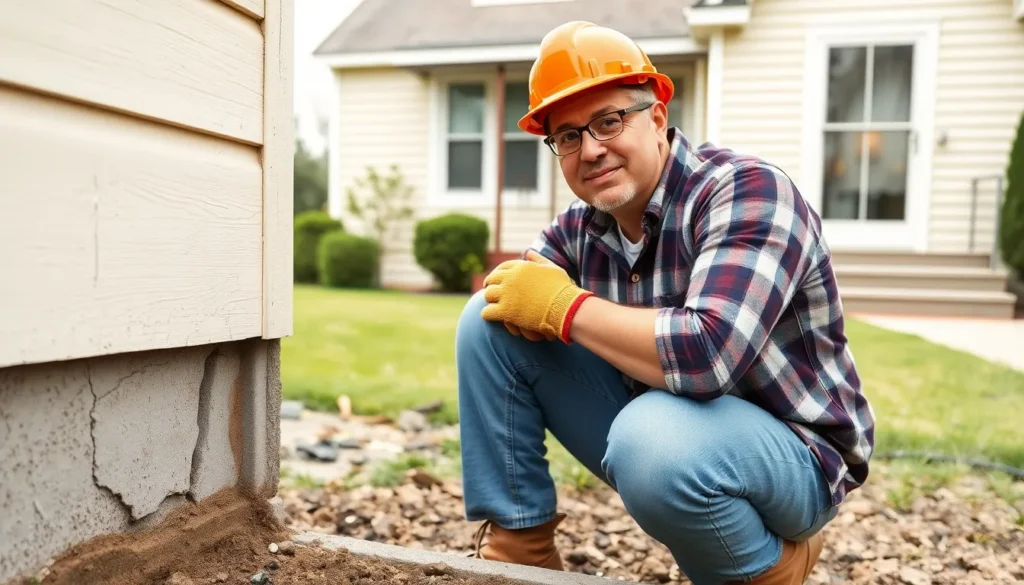A solid foundation is the backbone of any home, but what happens when that backbone starts to wobble? Cracks in walls, uneven floors, and doors that refuse to close are more than just quirky home features—they’re signs that your foundation might need a little TLC. Ignoring these warning signs is like ignoring a sneeze during flu season; it’s best to address it before it spirals out of control.
Table of Contents
ToggleWhat Is Home Foundation Repair?
Home foundation repair involves correcting issues with a home’s structural base. A compromised foundation can affect the entire house. Repair methods vary, depending on the type and severity of the damage.
Common methods for foundation repair include underpinning, slab jacking, and piering. Underpinning strengthens the foundation by extending it deeper into the soil. Slab jacking involves injecting a material under the foundation to lift it back to its original position. Piering uses piers driven deep into the ground to support the home’s weight.
Identifying the signs of foundation problems is crucial. Homeowners should look for cracks in walls and ceilings, misaligned windows and doors, and sloping floors. These signs often indicate underlying issues that require immediate attention.
Addressing foundation problems promptly prevents further structural damage. Ignoring early warning signs can lead to costly repairs down the line. Foundation repair not only stabilizes the house but also enhances its value.
Choosing a qualified contractor is essential for effective repairs. Professionals utilize advanced tools and techniques to assess the foundation’s condition. They provide tailored solutions based on the specific needs of the homeowner.
Checking for warranties on repair work adds an extra layer of protection. Many reputable companies offer guarantees for their services, ensuring long-term peace of mind. Engaging with a trusted expert ensures that the home foundation repair process is completed efficiently and effectively.
Common Signs of Foundation Issues

Identifying foundation issues early leads to effective repair solutions. Several key signs indicate a home may require foundation repair.
Cracks in Walls and Floors
Cracks in walls are a common sign of foundation problems. Vertical cracks often indicate settling, while horizontal cracks could signify more serious issues. Inspecting both interior and exterior walls for irregularities helps homeowners assess damage. In addition, floors may display cracks, particularly in concrete slabs. Homeowners should address any visible crack, regardless of size, as it could signify underlying foundation stress.
Uneven Floors
Uneven floors frequently signal foundation issues. A noticeable slope or sagging in a floor can suggest that the foundation is shifting. Homeowners may notice gaps between the floor and the baseboards as further evidence. Concrete slabs may heave or sink, exacerbating the problem. Promptly evaluating floor conditions can uncover foundation weaknesses before they escalate into larger problems.
Doors and Windows Misalignment
Doors and windows becoming misaligned often point to foundational concerns. Homeowners might struggle with sticking doors or gaps between frames and walls. These indications may suggest that the home’s structure is shifting due to shifting foundation support. Repairing aligned door and window frames allows for proper function while addressing the root cause is crucial. Noticing these signs early can prevent more significant structural damage in the future.
Methods of Foundation Repair
Repairing a home’s foundation involves several approaches. Each method effectively addresses specific issues with different structural concerns.
Piering and Underpinning
Piering and underpinning provide support to a sinking foundation. These methods involve installing piers deep into the ground, reaching stable soil or bedrock. Steel or concrete piers are typically used. Given its effectiveness, underpinning not only stabilizes foundations, but also raises them when sinking occurs. Homeowners often choose this method for severe settlement issues.
Slabjacking
Slabjacking lifts settled concrete slabs back to their original position. This process involves injecting a mixture of materials, such as polyurethane or cement, beneath the slab. As the mixture expands, it fills voids and raises the concrete. It’s a less invasive method than many alternatives, making it appealing to homeowners. Professionals recommend slabjacking for minor to moderate foundation issues.
Wall Anchors
Wall anchors provide support for bowing or leaning walls. They consist of steel rods anchored to stable soil and connected to the wall with brackets. By applying pressure, these anchors pull the wall back into alignment. Homeowners often consider this method for issues caused by hydrostatic pressure. It’s an effective solution for retaining walls and basement walls.
Choosing a Foundation Repair Contractor
Selecting a qualified foundation repair contractor is crucial for effective repairs and long-term stability. Homeowners must ensure they partner with professionals who possess the right skills and experience.
Qualifications to Look For
Licensing and insurance are fundamental qualifications. A licensed contractor adheres to industry standards, while insurance protects homeowners from liability. Experience in foundation repair is another key factor. Contractors with several years in the field likely possess valuable knowledge of various repair techniques. Customer reviews offer insights into a contractor’s reputation. A strong portfolio showcasing past projects can indicate a contractor’s capability. Look for certifications from reputable organizations, as these demonstrate ongoing education and commitment to best practices.
Questions to Ask
Inquiring about experience levels is vital. Asking how many similar projects the contractor has completed provides context for their expertise. Homeowners should also question the techniques used for specific issues. Understanding the methods ensures appropriate solutions for unique problems. It’s important to ask about warranties on materials and workmanship as this reflects the contractor’s confidence in their work. Clarifying timelines for the repair process can help set expectations. Finally, discussing payment options allows for understanding cost structures and project financing.
Cost of Home Foundation Repair
Understanding costs associated with home foundation repair is essential for homeowners. Several factors influence the overall expense of foundation repairs, including the extent of the damage and the chosen repair method.
Factors Affecting Cost
Location significantly impacts foundation repair costs. In urban areas, labor and material expenses typically increase. Size of the foundation also matters; larger homes often require more extensive repairs. Severity of the damage plays a crucial role as well. Minor issues might incur lower costs, while significant structural problems demand more involved solutions. Type of repair method varies in pricing. For example, piering may cost differently than slab jacking. Finally, contractor rates differ based on experience and qualifications, which can affect the total investment.
Typical Price Ranges
Price ranges for home foundation repair generally fall between $2,000 and $7,000. Minor repairs could be as low as $1,500, while extensive work might exceed $10,000. Slab jacking typically costs between $1,500 and $3,000 per slab. Piering methods usually range from $1,000 to $3,000 per pier. Lastly, underpinning often falls in a similar range of $1,500 to $4,000, depending on project specifics. Understanding these ranges helps homeowners budget effectively for necessary repairs.
Addressing foundation issues is vital for maintaining a safe and stable home. Homeowners should stay vigilant for signs of damage and act quickly to prevent further complications. Choosing the right repair method and a qualified contractor can make all the difference in ensuring effective solutions.
Investing in foundation repair not only safeguards the structural integrity of a home but also protects its value over time. By prioritizing these repairs, homeowners can enjoy peace of mind knowing their foundation is secure and their home is a safe haven for years to come.






